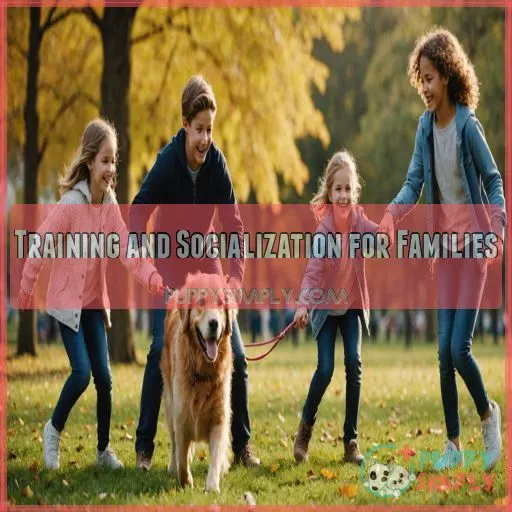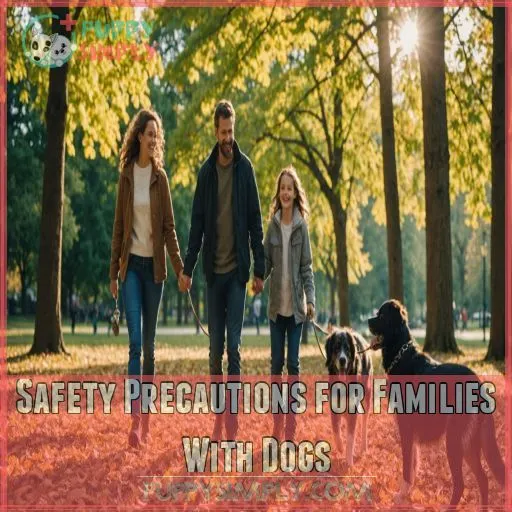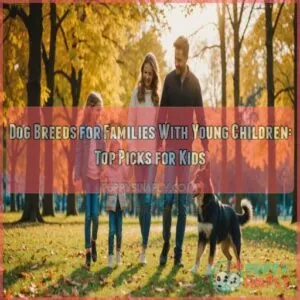This site is supported by our readers. We may earn a commission, at no cost to you, if you purchase through links.

These dogs fit right into active homes and adore a good game of fetch, making them perfect partners for adventurous kiddos.
If you’ve got a lively household, consider high-energy breeds like Australian Shepherds or Border Collies to keep everyone on their toes.
Just remember, every pup needs love, patience, and a pinch of training. It’s all about finding that perfect wagging tail to match your family’s vibe—because every family deserves a furry friend to create memories with!
Table Of Contents
- Key Takeaways
- Choosing the Right Breed
- Popular Dog Breeds for Families
- Breeds With High Energy Levels
- Breeds With Gentle Temperaments
- Factors to Consider for Older Children
- Dog Breeds Suitable for Older Children
- Training and Socialization for Families
- Safety Precautions for Families With Dogs
- Health Considerations for Family Dogs
- Long-Term Commitment to Dog Ownership
- Frequently Asked Questions (FAQs)
- What is the most child friendly dog breed?
- What is the best dog for a 10 year old boy?
- What is the best dog for all around family?
- What is the safest dog breed?
- How do I introduce a new dog to my older children?
- What are the grooming requirements for family-friendly dog breeds?
- How can I ensure my dog and older children get along well?
- What are the best ways to teach older children dog handling skills?
- How do I choose a dog that will be a good fit for my active lifestyle?
- Conclusion
Key Takeaways
- When choosing a dog for your family, consider your daily hustle and bustle. Look for breeds that match your lifestyle, whether you’re couch potatoes or adventure junkies, and remember, a happy pup equals a happy home.
- Beagles and golden retrievers are like the seasoned camp counselors of the dog world, perfect for families with older kids due to their playful yet patient nature.
- Don’t skip your homework – research breeds that fit well with your living space and budget. Some dogs think they’re mini-horses and need a yard, while others are city slickers who’ll thrive in an apartment.
- Training and socialization are like Netflix binges – they take time but are totally worth it. Get your kids involved in teaching your new fur buddy the ropes, and you’ll build a bond that’s stronger than a superhero’s cape.
Choosing the Right Breed
Choosing the right dog breed for your family isn’t as easy as picking the cutest pup at the shelter; it’s about finding a new family member who’ll fit right in, especially if you have older kids.
From chatting with a vet to thinking about your own circus-like lifestyle, this guide will help you find a furry friend who can put up with all those teenage moods and learn about potential health issues!
Consider Your Family’s Lifestyle
When choosing a dog breed, think about your family’s lifestyle. Do you like cozy family time or adventures?
Consider these factors:
- Dog activity: Energetic or laid-back pups? Match their energy to your routine.
- Space needs: Big dogs need room to roam, while small breeds fit limited spaces.
- Budget impact: Factor in costs like food, vet visits, and grooming.
Research Breeds Known for Gentle Nature
Researching breeds known for their gentle nature is key when choosing a family dog, like the Black Russian Terrier.
Look for breeds like Cavalier King Charles Spaniels, Newfoundlands, and Pugs – these pups are renowned for their patience, affection, and tolerance around children.
With a little digging, you’ll find the perfect furry friend for your household.
Visit a Local Shelter or Rescue Organization
After learning about gentle breeds, let’s pivot to meeting your potential furry friend.
Visit a local shelter or rescue organization where you can meet dogs and explore adopting one.
It’s a bit like speed dating but with wagging tails and slobbery kisses!
You might discover family-friendly dogs that fit your dynamics perfectly.
It’s a rewarding adventure!
Talk to a Veterinarian or Dog Trainer
Before choosing a dog breed, chat with a veterinarian or dog trainer.
They’ve got a treasure trove of insight on breed recommendations and training tips.
Whether you’re curious about dog behavior or pondering which dog breeds for kids suit your family, they can guide you.
It’s like having a GPS for pet possibilities—don’t navigate this journey alone!
Be Prepared to Commit to Training and Socialization
When you bring a dog into your family, be ready to jump into training and socialization.
Think of puppy classes as your dog’s college – everyone’s getting schooled!
Use positive reinforcement to make learning a game.
With obedience training and these socialization tips, your dog becomes an A+ family member, especially with teenagers and young adults.
Popular Dog Breeds for Families
If you’re looking for the perfect family dog, certain breeds stand out for their gentle nature and ability to thrive with older children.
From the ever-popular Labrador Retriever to the loyal and affectionate Beagle, these pups make wonderful companions that will shower your family with unconditional love.
Labrador Retriever
If you’re searching for the best family dogs, consider the Labrador Retriever.
Known for their friendly temperament and ease of training, they’ll fit right into your family like a glove.
These pups love activities, so they’re perfect for families with large dogs or multiple pets.
Plus, their grooming needs are a walk in the park!
Golden Retriever
Golden Retrievers, always the cheerful souls, fit like a glove in family settings.
Their friendly disposition means they get along well with kids and other pets.
Plenty of Golden Retriever exercise is essential, as their energy levels rival a toddler on candy.
Regular Golden Retriever grooming keeps their coats shiny, while steady Golden Retriever training brings out their delightful temperament.
Beagle
Say goodbye to your worries about finding a canine bestie! Meet the Beagle—a merry companion perfect for families with older kids. This breed adores company, making it a go-to for busy, social families.
Beagle exercise offers training and fun with its lovable Beagle temperament.
Don’t forget Beagle grooming and health check-ups—keeping them ready for adventure!
Boxer
Boxers are loyal, affectionate, and intelligent dogs with a playful nature – perfect for families with older children.
They’ll happily join in on outdoor adventures, while their gentle temperament means they’ll be patient playmates.
Just be ready to provide plenty of exercise and training to channel that boundless enthusiasm.
Collie
Thinking of adding a Collie to your family mix? These majestic, intelligent dogs have a rich history of herding and offer a gentle temperament that’s great for families with older children. Here’s why Collies make a fantastic furry companion:
- Collie Training: They’re quick learners.
- Collie Grooming: Regular brushing is essential.
- Collie Health: Generally robust with proper care.
They’re the whole kit and caboodle!
Breeds With High Energy Levels
If your family loves outdoor adventures where energy and excitement are abundant, exploring dog breeds with high energy levels can be the perfect fit.
These dogs, like Australian Shepherds and Border Collies, will keep up with your kids’ boundless enthusiasm and might even win a race or two!
Australian Shepherds
Stepping up the energy ladder, meet Australian Shepherds. They’re like furry dynamite with their exercise requirements! Perfect for families with older kids, these herding wizards keep everyone on their toes.
Australian Shepherd training can be as rewarding as a warm hug, especially when you learn about their strong prey drive!
| Feature | Pros | Considerations |
|---|---|---|
| Training | Highly trainable | Needs consistent practice |
| Herding Instincts | Great at keeping everyone together | Can herd family members, too! |
| Grooming Needs | Moderate grooming keeps them pretty | Regular brushing prevents tangling |
| Health | Generally healthy with good care | Watch for hip issues |
Border Collies
Border Collies are whirlwinds of energy, always ready to herd and chase.
Their intelligence and herding instinct make them a handful, but with proper training and plenty of exercise, these brainy pups can be wonderful companions for active families with older kids who can appreciate their boundless enthusiasm.
Just be ready to brush that fluffy coat regularly!
Jack Russell Terriers
Considering a Jack Russell terrier? These lively pups are like batteries that never run out—they’ll keep your family on its toes!
Jack Russell terrier training and regular exercise are essential.
Despite their spunky demeanor, their loyal, loving nature makes them great dog breeds for families with older children looking for endless fun and adventure.
Poodles
Got energy? Poodles do! They’re ideal for active families with older kids due to their zest for life.
Don’t forget Poodle grooming; those fluffy coats need TLC.
With Poodle training, you’ll nurture their sharp minds, ensuring they become delightful companions.
Known for their playful temperament, Poodles keep everyone on their toes, making them top dog breeds for families with children.
Retrievers
Retrievers are the Energizer Bunnies of the dog world, making them perfect for families with teenagers or grown kids.
Their playful, enthusiastic-to-please personality thrives on adventure and interaction.
Retriever training keeps their intelligence sharp, while Retriever grooming maintains their stunning coats.
Choose Retrievers for a lively companion who’s as loyal as your favorite weathered blanket.
Breeds With Gentle Temperaments
If you’re looking for a gentle, affectionate pup to add to your family, breeds like Bichons Frises, Cavalier King Charles Spaniels, and Newfoundlands are worth considering.
These loyal companions are known for their patience and loving nature, making them great choices for households with older children.
Bichons Frises
If you’re seeking a fluffy companion matching your family’s gentle pace, consider a Bichon Frise.
With their cheerful temperament, they’re the comedians of the dog world.
Their low-shedding coat demands regular grooming, while moderate exercise and training keep them healthy and happy.
Perfect dog breeds for families with older children, these affectionate furballs thrive on love and laughter.
Cavalier King Charles Spaniels
Cavalier King Charles Spaniels are the epitome of gentle companionship, making them really great dog breeds for families with older children.
Their loving personality and moderate grooming needs mean they’re a delightful fit for any home.
Training them is a walk in the park, thanks to their willingness to learn.
With a lifespan of 12-15 years, you’ll enjoy years of delightful camaraderie!
Newfoundlands
After meeting charming Cavaliers, now imagine a dog as big-hearted as it’s big-footed: the Newfoundland.
With a temperament as gentle as a summer breeze, this breed is perfect for families with teenagers or older children.
While they’re hefty in size, their grooming and training needs aren’t overwhelming.
Don’t fret about health; regular vet visits will do wonders.
Pugs
Pugs are the perfect pint-sized pals for families with older children.
These affectionate, playful pooches are keen to please and form strong bonds with their human pack.
Their calm, gentle nature makes them wonderful companions,
while their low-maintenance grooming needs and moderate exercise requirements fit nicely into busy household routines.
Pugs’ charming personalities and adaptability make them a delightful choice for families.
Shih Tzus
If you’re charmed by pugs, wait till you meet the Shih Tzu! These adorable dogs bring joy with their lion-like mane and loving nature. Ideal for families with older kids, they offer companionship without the allergy-scare.
Here are some quick tips:
- Groom their silky coat regularly.
- Promote Shih Tzu health with exercise.
- Shape behavior through Shih Tzu training.
- Appreciate their rich Shih Tzu history.
Factors to Consider for Older Children
When picking a dog for your older kids, think about their maturity and how well they can handle pet care.
Make sure everyone can breathe easy by checking for allergies—because nobody wants to sneeze their way through fetch!
Age and Maturity Level
Choosing dog breeds for families with older children means factoring in a child’s responsibility and the dog’s maturity.
Older kids, like teenagers, bring unique energy—sometimes more Snapchat than fetch, right?
A dog that matches age-appropriate play is golden.
Consider how family dynamics change with adolescents or young adults and select a breed that complements those evolving roles.
Ability to Interact With Dogs Safely
As your children grow older, it’s really important they learn how to safely interact with dogs.
Teach them to read canine body language, approach pups calmly, and never disturb a dog while eating or sleeping.
With proper supervision and guidance, your family can enjoy fun, positive interactions that build trust and respect between kids and their furry friends.
Allergy Concerns
Dealing with allergies? Some hypoallergenic breeds might just be your ticket to sneeze-free cuddles! Allergy testing can reveal triggers, while consistent dog grooming and air purifiers keep symptoms at bay. Consider medication options if needed.
Choosing dog breeds for families with children with allergies helps everyone be happy. Remember, a well-groomed pooch can be your best friend without the tissue box!
Space and Living Situation
When considering a dog, think about your living space.
In apartments or condos, small, indoor dogs thrive.
Meanwhile, bigger breeds often prefer houses with large yards.
But don’t let home size be the tail wagging the dog; even in townhouses, you can create a playful environment.
Consider your space needs and the energy level of your furry friend!
Family Dynamics and Lifestyle
Picking a dog? It’s like choosing a new family member! Your dynamic and lifestyle make a difference. Consider these tips:
- Family time: Can you spend enough quality time with a pup?
- Activity levels: Got energetic teens or couch potatoes?
- Pet allergies: Keep sneezes at bay.
- Shared responsibilities: Who picks up after Fido?
Dogs thrive in balanced homes!
Dog Breeds Suitable for Older Children
If your family has older children, certain dog breeds may be a better fit.
Consider breeds like the Irish Setter, Brussels Griffon, and Basset Hound – they’re known for their gentle, affectionate temperaments and ability to thrive in homes with more mature kids.
Irish Setter
If you’re looking for dog breeds for families with older children, consider the Irish Setter.
Sporting a vibrant red coat and a personality as lively as its fur, this dog thrives in active households.
Irish Setter training becomes a joyous experience with its willingness to please attitude.
Don’t forget their grooming and exercise needs to keep their energy and health in top shape!
Brussels Griffon
Beyond the spirited Irish Setter lies the delightful Brussels Griffon. This dog is perfect for families with older children seeking a loyal companion.
- Affectionate: Loves cuddles and forming strong bonds.
- Adaptable: Thrives in both city apartments and suburban homes.
- Grooming: Regular brushing keeps their unique coat neat.
- Training: Responds well to patience and positive reinforcement.
So, ready for some wagging tails and hearty laughs?
Basset Hound
The Basset Hound, with its easy-going temperament and adorable floppy ears, is a great addition to families.
They’re not big on intense exercise, but they love leisurely walks and sniffing around the neighborhood.
Regular grooming is necessary to keep their coats shiny.
Perfect for families with older children and spacious suburban homes.
Cocker Spaniel
Cocker spaniels make wonderful companions for families with older children.
Their gentle, playful nature and willingness to please make them ideal playmates.
These affectionate pups thrive on daily exercise and bonding time with their favorite humans.
With proper training and socialization, cocker spaniels can be loyal, loving additions to any household.
Boston Terrier
Boston Terriers, affectionately dubbed "American Gentlemen," are great for families with older children.
Their easy-going demeanor fits well in small spaces.
Here are four reasons to love them:
- Temperament: Kind-hearted.
- Exercise: Enjoy brisk walks.
- Grooming: Low maintenance.
- Health: Generally sturdy.
With a Boston Terrier, you won’t need a cape; your superhero is right at home!
Training and Socialization for Families
Training and socialization aren’t just for the dogs—they’re for the kids too!
With a little patience and consistency, you’ll teach your children to be the best "dog whisperers" on the block, ensuring everyone wag their tails happily.
Importance of Training for Both Dogs and Children
Training isn’t just for the dogs; it’s a family affair! You’re the coach, and your pup and kids make up the star team.
Consistency is key, so incorporate positive reinforcement and safety first practices in every session.
Recognizing dog body language is an invaluable skill to understand potential fights between dogs.
After all, a well-trained dog creates a joyful home, ready to fetch happiness for everyone!
Teaching Children How to Interact With Dogs
Teaching your children how to properly interact with dogs is essential for their safety and the dog’s well-being.
Here are three key tips:
- Learn to recognize dog body language and teach your kids to respect a dog’s personal space.
- Establish clear safety rules, like no running, yelling, or approaching a dog without permission.
- Practice positive reinforcement – reward calm, gentle interactions to encourage responsible petting and play.
Socialization Techniques for Dogs
When kids learn to engage kindly, socializing pups shines bright.
Explore early socialization and puppy classes to foster ease in varied settings.
Socialization groups and dog parks? Perfect for group fun! Watch their personalities blossom.
Here’s a quick guide:
| Socialization Tips | Engaging Activities |
|---|---|
| Early Socialization | Puppy Classes |
| Group Play | Dog Parks |
Who thought dog breeds for families with older children could be this fun?
Positive Reinforcement Training Methods
Positive reinforcement is a no-brainer when training dog breeds for families with older children. Simply reward your pooch with timely treats, praise, or clicker training, and watch them wag their way to good behavior.
With:
- Delicious rewards that create smiles
- Timing that builds trust
- Treats that pave the path to success
You’ll foster a strong bond with your furry friend!
Consistency and Patience in Training
Consistency and patience are your best friends when training your dog.
Imagine training as a marathon, not a sprint—it’s about setting a steady pace and building trust over time.
Stick to consistent schedules and embrace positive reinforcement.
Reward-based training keeps things fun and manageable.
With patience, you’ll guide your dog and older children into a harmonious and rewarding relationship.
Safety Precautions for Families With Dogs
Keeping your family and furry friend safe is a top priority.
From teaching kids to read dog body language to creating a secure environment, we’ve some practical safety tips for you.
Supervising Interactions Between Dogs and Children
Training the whole family is key, but you’re not out of the woods yet! You must supervise interactions between dogs and children. Think of this like a referee in a match—keeping an eye on safe play areas.
Observe child behavior closely and remember, even the best dog breeds for families need an adult around.
Have an emergency plan ready, just in case!
Teaching Children How to Recognize Dog Body Language
Understanding dog signals can be a fun detective game.
Teach your kids to spot playful cues—like wagging tails—and relaxed signs, such as soft eyes.
Explain fearful signs, like tucked tails, and aggressive signs, like growling.
Recognizing these can help avoid miscommunication.
A family-friendly dog mightn’t talk, but its body language speaks volumes!
Preventing Dog Bites and Attacks
Preventing dog bites isn’t rocket science if you grasp dog body language and practice safe handling.
Teach everyone in your home to read canine cues—like a wagging tail or whale eyes.
Kids can be excitable, but responsible ownership means reminding them that not every dog wants to be hugged.
Prioritize bite prevention to keep the relationship harmonious and everyone smiling.
Creating a Safe Environment for Dogs and Children
Creating a safe environment for your kids and canine companion is a must.
Childproof your home by installing secure fencing, gating off rooms, and designating a cozy dog zone.
Supervise all interactions and teach your little ones how to properly approach and play with your furry friend.
With a bit of planning, you can make sure everyone enjoys quality time together.
Emergency Preparedness
In an emergency, be ready as a Boy Scout!
Stock up on a first aid kit and keep a pet carrier handy.
Have an evacuation route planned, complete with an emergency contact list.
First responders, firefighters, and healthcare workers are your allies.
Make sure everyone, from teachers to entrepreneurs, knows the drill.
Your dog will appreciate your foresight!
Health Considerations for Family Dogs
When you’re picking a dog breed for your family, it’s important to know what health problems they might face.
A healthy dog makes for a happy home, so let’s make sure you tackle regular check-ups and vaccinations like a pro!
Common Health Issues in Family Dog Breeds
From hip dysplasia to allergies, family dog breeds can face health hurdles.
Obesity creeps in like an unwelcome guest if they enjoy townhouses or condos without ample romp time.
Their dental care is as important as yours, helping prevent joint problems as they age.
Choose wisely, whether in rural homes or apartments, and keep tails wagging!
Importance of Regular Veterinary Check-Ups
Regular veterinary check-ups are a must for keeping your family pup healthy and happy.
These visits allow your vet to catch any issues early, monitor growth, and make sure your dog’s preventative care is on track.
Think of it as an annual wellness exam – just like you’d get for yourself!
- Routine physical exams
- Parasite testing and prevention
- Vaccination schedule updates
- Nutritional counseling
Preventative Care and Vaccinations
Keeping your furry friend healthy isn’t rocket science. Puppy shots lay the foundation. Know your vaccination schedule—it’s your dog’s safety net against common diseases.
Vet visits catch issues early and make sure parasite prevention, whether you’re in humid or dry climates.
Dogs thrive with love and care, be it in temperate homes or cold climates.
Nutrition and Diet for Family Dogs
Just like us, dogs thrive on the right diet. Whether you’re whipping up homemade chow or evaluating dog food ingredients, balance is key. Avoid dog food allergies by knowing their nutritional needs.
Imagine your pup as either a homebody or social butterfly; their energy level can guide feeding schedules to keep them happy and healthy.
- Consider life stage and size
- Monitor weight changes
- Consult your vet regularly
- Stick to routine feeding times
Managing Health Issues in Family Dogs
Feeding your family dog the right diet’s important, but what happens when they’re under the weather?
Staying on top of preventative care and understanding common ailments is like a safety net.
A little emergency prep goes a long way, especially with senior dogs.
Know your breed’s quirks and needs.
It’s like having an owner’s manual for their health!
Long-Term Commitment to Dog Ownership
Adopting a furry friend is a big commitment – are you ready for the long haul?
From covering vet bills to making time for daily walks, dog ownership requires serious thought.
But the unconditional love and companionship make it all worthwhile.
Understanding the Lifespan of Different Breeds
Understanding breed lifespan variations can be a head-scratcher, but knowing what to expect helps with long-term planning and aligning your lifestyle with your pet.
Average dog lifespans differ:
- Small breeds, like Dachshunds, often live longer (up to 15 years).
- Medium breeds, such as Beagles, average around 10-13 years.
- Large breeds, like Great Danes, typically see 7-10 years.
Financial Considerations for Dog Ownership
| Expense Type | Average Cost | Frequency |
|---|---|---|
| Dog Food Costs | $50/month | Monthly |
| Vet Expenses | $200/year | Annual |
| Grooming Fees | $40/visit | Quarterly |
Dog ownership requires careful budgeting for a happy, well-kept pooch!
Time Commitment for Dog Care and Training
Owning a dog isn’t just fun; it’s a time commitment. You’ve got to think about your daily routine.
Training schedules aren’t set-it-and-forget-it deals, and you might need a dog walker or pet sitter for busy days.
Emotional Preparation for the Loss of a Pet
Saying goodbye to a beloved pet can be one of life’s most difficult moments.
But with the right emotional preparation, you can navigate this challenging time with grace.
Here are 3 tips to help you cope:
- Allow yourself to grieve openly.
- Create meaningful rituals to honor your pet’s memory.
- Seek support from loved ones or pet loss support groups.
Creating a Forever Home for Your Dog
Dog-proofing your home is like setting the stage for a pup-friendly paradise. Choose dog-friendly furniture that can withstand a wagging tail or two. Embrace dog-specific decor to add charm.
Set boundaries early on and engage in dog-related activities to bond.
Frequently Asked Questions (FAQs)
What is the most child friendly dog breed?
Fun fact: labrador retrievers consistently rank as America’s top dog.
They’re friendly, patient, and adaptable, making them fantastic companions for kids.
Just be ready for endless playtime and a lot of wagging tails!
What is the best dog for a 10 year old boy?
Labrador Retrievers are a fantastic choice for a 10-year-old boy, offering companionship, patience, and energy to keep up with young adventurers.
These friendly, trainable dogs will be your child’s fervent playmate and loyal buddy.
What is the best dog for all around family?
Golden Retrievers might just be the Swiss Army knife of family dogs, offering loyalty, playfulness, and gentle spirits.
They’ll wag their tails straight into your hearts, fitting perfectly into any family dynamic with their friendly nature.
What is the safest dog breed?
Golly gee, when it comes to finding the safest dog breed, you can’t go wrong with the ever-reliable Newfoundland. These gentle giants are the epitome of patience and loyalty, making them a paw-fect pick for families.
Here are some additional details on the Newfoundland breed:
Newfoundlands are known for their gentle, patient, and loyal temperament, making them an excellent choice for families with children. These gentle giants are often referred to as "nanny dogs" due to their natural instinct to protect and care for children.
Newfoundlands are large, powerful dogs, but they’re surprisingly gentle and affectionate. They’re known for their calm demeanor and willingness to please, which makes them easy to train and socialize. These dogs are also highly intelligent and keen to learn, further contributing to their suitability as family companions.
In addition to their gentle nature, Newfoundlands are also known for their water-loving tendencies and impressive swimming abilities. They were originally bred as working dogs to assist fishermen, and their webbed feet and thick, water-resistant coats make them excellent swimmers. This can be a great asset for families who enjoy water activities like swimming or boating.
How do I introduce a new dog to my older children?
Ease your new pup into the family by letting your kids help with feeding times, treats, and short play sessions.
Gradually introduce boundaries, ensuring everyone understands respect.
Eventually, your home will feel like one big, happy pack!
What are the grooming requirements for family-friendly dog breeds?
When choosing a family-friendly dog, consider grooming.
Some breeds demand Cinderella-like attention daily, like Poodles or Shih Tzus, while others, like Beagles or Bulldogs, require less fuss.
Regular brushing, occasional baths, and nail trims keep them spiffy.
How can I ensure my dog and older children get along well?
Teach your children to understand canine body language and set boundaries.
Involve them in training using positive reinforcement and supervise interactions.
This builds a stronger bond, ensuring they’re like peas in a pod, safe and happy together.
What are the best ways to teach older children dog handling skills?
Get your kids involved in training sessions – they’ll learn proper handling skills and bond with the pup.
Make it fun with treats and games, and you’ll have a well-behaved, happy family dog in no time.
How do I choose a dog that will be a good fit for my active lifestyle?
Think of a dog as the rhythm to your life’s dance.
For an active lifestyle, choose an energetic breed.
Consider a Labrador Retriever or Australian Shepherd; they’ll match your pace and keep your adventures lively and engaging.
Conclusion
When choosing dog breeds for families with older children, remember, variety is the spice of life! Whether you’re welcoming a bouncy Labrador or a gentle Bichon Frise, the key is finding a breed that fits seamlessly into your daily routine and family dynamic.
With the right playmate, your kids gain a buddy for adventures and a lesson in responsibility.
So, jump in with both feet—it’s time to find the perfect four-legged tail-wagger for your family!
















